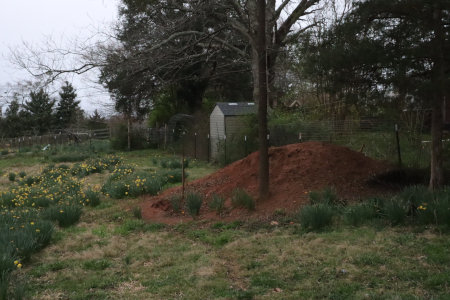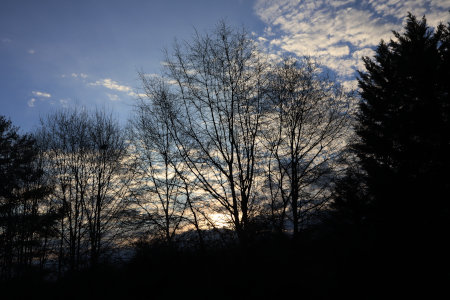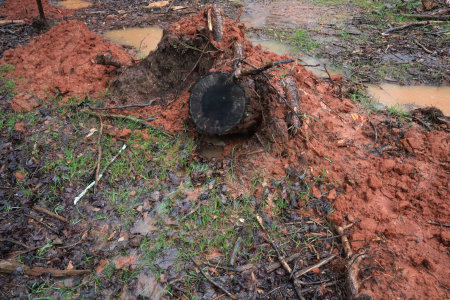Closing out March with a few random photos from my March photo folder.
March 28, 2022
March Photos
March 24, 2022
Interesting Things I've Learned With a Shovel
Once upon a time, I thought of shovels as simply tools for moving things like dirt, compost, or mulch. While it's true that they are, I've also come to understand that they are invaluable learning tool as well. It's my first tool for soil analysis; a carefully removed shovel depth of soil reveals its physical structure: type, texture, color, and presence of organisms and organic matter. Then there was poking around in the dirt where I put my first forest garden. That was almost like an archaeological dig.
This particular episode in my ongoing learning adventures started when I planted two quince seedlings in the goats' browse area. I'd ordered four seedlings, of which two went above the annuals garden. Then I started learning about swales and wondered if I could help those little trees by digging a small trench-like swale between them. What I learned changed everything.

|
|
Digging the trench led to an interesting discovery, which led to transplanting the little quince trees again. |
While digging the trench, I observed water seeping through the clay subsoil and filling the trench. Odd, I thought. Even odder was that water sat in the trench for weeks afterward. Unlike our garden swale, which soaks up the water in about two days, the water here was very slow to soak into the ground.

|
| Ridge and old swale above where the quince trees were planted. |

|
| Two ridges below where they were planted. |
We discovered a series of puddles both uphill and downhill from where I planted the quince trees. However, there wasn't observable overland runoff. Coincidence? Or is something else going on?

|
| If you can spot her, Meowy is squatted down near my 1st trench. |

|
| I dug about this deep and then something interesting started to happen. |

|
| Water started to seep through the clay and fill my little trench. |

|
| It filled quickly enough to make ripples in the water! |

|
| The water fill pretty much stopped when it reached this level. |

|
|
I dug another trench a few feet over, and it too started to fill, though not as quickly nor as much. |
The next time it rained, I was curious to see what was happening.

|
| This shot was taken looking down on my trenches. |

|
| The two lower test trenches had filled with water too (top of the photo). |

|
|
The trench on the left not only filled, but overflowed. |
Where did the overflow go? Both around and under the old pine stump.

|
|
The hole was made by an uprooted pine tree and is in line with the flow of water I'm following. |
I've been observing the trenches daily after it rains. My observations are that the two lower trenches drain before the top trench does. And while my garden swale holds water for about two days, the top trench holds water for several weeks.
- There is a lot of water moving underground here, even when it's not raining.
- Soil conditions are right to retain water here for a longer time than elsewhere.
 |
| Looking uphill. That's the old swale in the foreground. |
 |
| Continuing uphill. The green is one of our goat paddocks. My forest garden is uphill from that. |
Over the years, Dan and I have talked about putting in a pond, although we never thought about putting one here. Yet thanks to a shovel, we've made some interesting observations about our land and how it responds to rainfall. Will we ever actually dig a pond? I have no idea. When I took my online permaculture design course, Bill Mollison and Geoff Lawton had really interesting things to say about what happens after the land is re-hydrated by swales and ponds. They also discussed how productive aquaculture can be. So, a future pond for us? It's definitely something to consider.
March 20, 2022
Piano to Desk Conversion
Several years ago, Dan found a free piano on craigslist and got it for me. I took piano lessons at university and loved it. It's something I always wanted to return to, but never had a chance. Unfortunately, the piano needed a lot more than a simple tuning, so it has sat in the corner of our living room since then.
One indoor day this past winter, Dan got to wondering what he could do with it. We tossed around some ideas, did a little online research, and discovered that people do all kinds of things with old pianos and their parts. We both liked the idea of turning it into a desk.

|
|
I don't seem to have a picture of it all put together, but here it is with the upper front board removed. |

|
| Lots of strings and tuning pins to be removed. |

|
| The date embossed on it is 12-22-55. Some people turn these into a wall art harps, but it is extremely heavy! |

|
|
That left the pin block (top, with the tuning pin holes in it) and the bridges. The bridges were a challenge because they were both screwed and glued. |

|
| Fortunately, the glue was water soluble. We decided to leave the pin block. |
Next, he started reassembling it.
 |
| Looking at the bottom with the piano on its back. The caster wheels made it too high for a desk, so he removed those and added some "feet" for stability. |
 |
| The piano underside board was a perfect fit for a bottom shelf. |

|
|
The front bottom board fit perfectly to make the desk top. |

|
| Dan glued finished plywood over the pin block and sound board for a nicer finish. |
 |
| The last thing to do was to add a shelf. The board was a remodel save, originally from one of our closets. The width is to accommodate radios. |
With the piano moved out of the living room, we decided to do something else we've talked about. As we've replaced windows and worked on walls we've added insulation. But the living room walls are plastered, and we didn't want to mess with that. So we opted to install a corkboard veneer on the wall.

|
| This is half-inch corkboard insulation. It's just natural cork with no glues added. |
 |
| Finished and ready for fitting out. |
We talked about staining the plywood and shelf to match to color of the piano, but I kinda like the contrasting light color. It helps keep that corner of the room from being too dark.
Old pianos are either free or pretty cheap to be had. It's often an item people want to get rid of when they move. They aren't solid wood because they are veneered, but they are real wood, as opposed to what cabinets and furniture are made from nowadays. So for anyone with a little creativity and enjoyment for working with wood, the possibilities are endless.
March 16, 2022
Our Agrarian Year: Spring Project List
March (the old agrarian new year) marks the beginning of spring, which is planting season! Our project prioritizing motto is "food first." So, hopefully, we've gotten the maintenance and winter projects to a good stopping point, so we can set everything else aside to focus on planting. Even if we haven't, this seasonal project takes priority over everything else, save emergencies.
Seasonal
- Planting
- Annual food crops
- Pasture forage
- Cleaning out the barn (of which the winter's accumulation of deep litter is spread across newly planted areas in the pasture)
- Prepare for April kidding
- Continue working on swales
 |
| Big pile of dirt where the swale needs to go. |
That pile came from the old swimming pool, which Dan dug out to see if we could do anything useful with it. That's where he put the dirt, and that's where it's stayed for over two years now. Our tractor doesn't have a front end loader, and trying to move it all by hand is a discouraging idea, so there it's sat.
- Finalize design and materials list for masonry heater (construction will be a summer project)
- Do something useful with our remaining two solar panels
- Finish the exterior of the house
 |
| Last exterior wall in need of new siding and paint. |
March 13, 2022
Enter The Lion
March came in like a lamb and gave us eight days of glorious spring weather: warm but not hot, low relative humidity, and mostly sunny. Then the lion showed up and chased the lamb away as a reminder that March is a fickle month in regards to weather.
Our forecast was for heavy rain, high wind, and plummeting temperatures. In combination, this is a recipe for heavy ice coating everything, crashing trees, and smashing power lines. Thankfully, these elements spread themselves out over two-and-a half-days.
An intense thunderstorm came first, depositing an inch and a third of rain overnight. When the sun came up, the wind came roaring through. Even though the temperature dropped steadily throughout the day, the wind and sun dried everything off so that when we woke up to 22°F (-6°C) this morning, we still had power and a safe walk to the barn.
While the goats were eating their breakfast, I took a walk with my camera to see what I could see.
 |
| Strawberries |
 |
| Puddle |
 |
| Daffodils |
 |
| Ice in the garden swale. |
 |
| Ice crystals growing from bare damp soil. |
 |
| More ice crystals. Fascinating, aren't they? |
Winter weather doesn't last long this time of year, so now, we're heading into another warming trend. Even so, it's a good reminder not to be seduced by spring's siren call of "plant your seeds, transplant your seedlings." I just hope everyone else in my part of the world fared as well with this weather event.
March 9, 2022
New Year's Celebration
Winter's dormant season has come to an end in my little part of the world. Everything is waking up and celebrating with color!

|
| Peach tree blooming. |
 |
| Violets |

|
| Forsythia |

|
| Periwinkle |

|
| Late daffodils |

|
| Rosemary blossoms |

|
| Spirea |
 |
| Early azaleas |
 |
| Grape hyacinths |
 |
| Greens: kale, collards, dandelion, wild lettuce, chickweed. The chickens are laying again, so hard boiled eggs. Plus feta cheese stored in olive oil, grated. |











